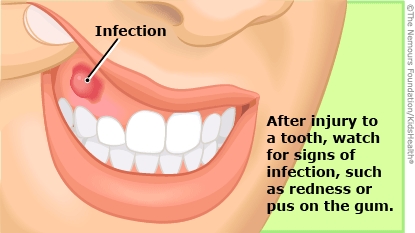Permanent teeth are the adult teeth that come in after kids lose their primary or "baby" teeth. Kids usually begin to lose their baby teeth when they're about 6 years old. Then the permanent teeth come in over the next 15 years. A permanent tooth can get chipped, cracked, knocked loose, pushed into the gum, or knocked out and always needs treatment as soon as possible.
Use these instructions to care for your child and know what to watch for.



Your child:

What can happen from permanent tooth injuries? A permanent tooth injury can cause a tooth to change color or position. It may also lead to an infection of the tooth. If treated early, an injured permanent tooth often can be saved.
How do dentists treat permanent tooth injuries? Treatment depends on the injury. Dentists can usually fix a chipped tooth by reattaching the chip or filling it in with a tooth-colored material. Teeth with large chips or cracks or that are pushed into a gum might need a root canal (removing the pulp inside the tooth, then cleaning and sealing it) and/or a crown (a tooth-shaped cap put over the injured tooth). Sometimes a tooth is fully knocked out or can't be saved. To replace it, dentists might use an implant (a device drilled into the jawbone to hold a replacement tooth).
What can help prevent tooth injuries? Not all tooth injuries can be prevented, but these steps can help: